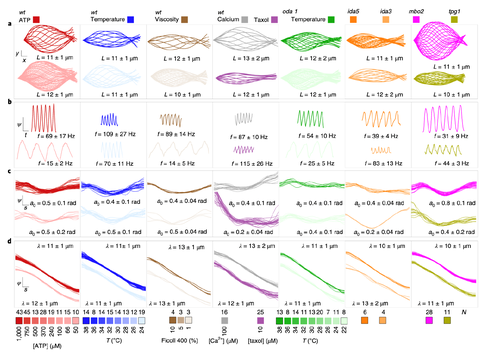Jan 28, 2022
Waveform Variability in Chlamydomonas Cilia Can Be Explained by Changes in the Curvature Response Coefficients of Dynein Motors

Variability of Waveforms in Chlamydomonas Cilia
In a new article published in the journal Nature Physics, an international team of scientists from the Instituto Gulbenkian Ciência in Lisbon, Yale University in New Haven and, the B CUBE - Center for Molecular Bioengineering at the TU Dresden demonstrates that cilia beat patterns vary substantially for a range of different perturbations, but all these seemingly different changes of cilia waveforms can be explained by changes of only a few parameters in a single model of cilia motor control by local curvature.
Motile cilia are a bestseller of nature. These microscopic slender cell appendages not only propel sperm cells at the beginning of life, but they also help establish the left-right body axis during embryonic development, or clear mucus and pathogens from our airways, with severe consequences for health in case of malfunction. The green alga Chlamydomonas swims like a breast swimmer with two cilia towards favorable light conditions, serving as a versatile model to study these highly conserved cell organelles.
Motile cilia beat regularly like a whip due to the concerted action of thousands of dynein motors distributed along their length. How these molecular motors work together to generate complex bending waveforms is still unclear. One research roadblock in the field is that different models may describe the same beat pattern equally well, and only perturbations may allow discriminating alternative models.
In this study, the authors exploited environmental and genetic perturbations of cilia to explore the variability of ciliary waveforms in a purified in situ system, where cilia are reactivated to beat without a cell body in the presence of an energy source. Cilia keep beating under a wide range of perturbations, including missing motor proteins, increased temperature, and reduction of the energy source ATP, but with altered waveforms. The authors used dimensionality reduction to identify two key parameters that account for 80% of the observed waveform variability. Through a simple mechanochemical model, the authors show how shape parameters are directly linked to fitted parameters of motor control, namely how the activity of these motors is geometrically controlled by the local curvature of the cilium.
The article presents the behavioral space of beating Chlamydomonas cilia and pinpoint, that cells may regulate ciliary waveforms by tuning the curvature sensitivity of dyneins. This identifies the mechanism of curvature sensing as a key avenue of future cilia research which is expected to provide novel insights into how cilia interact with the complex environments, they function in.
Original paper:
Geyer, V. F., Howard, J., & Sartori, P.: Ciliary beating patterns map onto a low-dimensional behavioural space. Nature Physics (January 2022).
Link:https://doi.org/10.1038/S41567-021-01446-2
